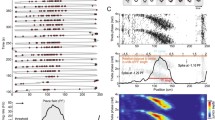Abstract
Dorsal hippocampal theta rhythm (Θ) and extracellular unit activity from CA1 pyramidal layer were recorded in awake guinea pigs, both during standing and during walking on a conveyor belt at increasing speeds. Amplitude, frequency and rhythmicity of Θ increased linearly with the movement speed. In this preparation we found the same three types of unit discharge patterns that have been described in anesthetized rats in the presence of spontaneous or induced hippocampal Θ: type 1, rhythmic at Θ frequency and phase-locked with Θ; type 2, discharging non-rhythmically but phase-locked with Θ; and type 3, discharging at random. Furthermore, all units modified their firing pattern when the animals walked, either by increasing their rhythmicity and/or phase-locking with Θ or by increasing their firing frequency. During walking, some type 3 units changed into type 2 or type 1, type 2 units changed to type 1, and type 1 increased their rhythmicity. Consequently, the unit discharge rhythmicity and phase-locking with Θ increased with the speed of movement. The mean rate of neuronal discharges increased linearly as a function of walking speed. In this paper we show that the progressive spectral Θ changes determined by the intensity of movement are concomitant with the increase in rhythmicity of hippocampal cells. Moreover, the firing rate of these cells, and the amplitude, frequency and rhythmicity of Θ, increased linearly as a function of walking speed, suggesting that neuronal excitation may be basically responsible for these changes in Θ properties.
Similar content being viewed by others
References
Alonso A, Gaztelu JM, Buño Jr W, García-Austt E (1987) Crosscorrelation analysis of septohippocampal neurons during Θ-rhythm. Brain Res 413:135–146
Arnolds DEAT, Lopes da Silva FH, Aitink JW, Kamp A (1979) Hippocampal EEG and behaviour in dog. II. Hippocampal EEG correlates with elementary motor acts. Electroencephalogr Clin Neurophysiol 46:571–580
Barrenechea C, Pedemonte M, Núñez A, García-Austt E (1995) In vivo intracellular recordings of medial septal and diagonal band of Broca neurons: relationships with theta rhythm. Exp Brain Res 103:31–40
Bland BH, Seto MG, Rowntree CI (1983) The relation of multiple hippocampal theta cell discharge rates to slow wave theta frequency. Physiol Behav 31:111–117
Buño W Jr, García-Sánchez JL, García-Austt E (1978) Reset of hippocampal rhythmical activities by afferent stimulation. Brain Res 3:21–28
Faris PD, Sainsbury RS (1990) The role of the pontis oralis in the generation of RSA activity in the hippocampus of the guinea pig. Physiol Behav 47:1193–1199
Fuentes J, Buño W Jr, García-Austt E (1981) Simulation of postsynaptic activities in hippocampal cells during theta rhythm. Brain Res Bull 7:157–162
García-Sanchez JL, Buño W Jr, Fuentes J, García-Austt E (1978) Non-rhythmical hippocampal units, theta rhythm and afferent stimulation. Brain Res Bull 3:213–219
Gaztelu JM, Buño W Jr (1982) Septo-hippocampal relationships during EEG theta rhythm. Electroencephogr Clin Neurophysiol 54:375–387
Green JD, Arduini AA (1954) Hippocampal electrical activity in arousal. J Neurophysiol 17:533–557
Jung R, Kornmüller AE (1938) Eine Methodik der Ableitung lokalisierter Potentialschwankungen aus subcorticalen Hirngebieten. Arch Psychiatr Nervenkr 109:1–30
Kirkwood PA (1979) On the use and interpretation of cross-correlation measurements in the mammalian central nervous system. J Neurosci Methods 1:107–132
Langley R (1971) Practical statistics simply explained. Dover, New York
Leung LS, Yim CY (1986) Intracellular theta in hippocampal CA1 pyramidal cells in the urethane-anesthetized rat. Brain Res 367:323–327
Luparello TJ (1967) Stereotaxic atlas of the forebrain of the guinea pig. Williams and Wilkins, Baltimore
Macadar O, Roig JA, Monti JM, Budelli R (1970) The functional relationship between septal and hippocampal unit activity and hippocampal theta rhythm. Physiol Behav 5:1443–1449
McFarland WL, Teitelbaum H, Hedges EK (1975) Relationship between hippocampal theta activity and running speed in the rat. J Comp Physiol Psychol 1:324–328
Núñez A, García-Austt E, Buño W Jr (1987) Intracellular Θ-rhythm generation in identified hippocampal pyramids. Brain Res 416:289–300
Perkel DH, Gerstein GL, Moore GP (1967) Neuronal spike trains and stochastic point processes. II. Simultaneous spike trains. Biophys J 7:419–440
Ranck JB Jr (1973) Studies on single neurons in dorsal hippocampal formation and septum in unrestrained rats. I. Behavioral correlates and firing repertoires. Exp Neurol 41:461–531
Whishaw IQ, Vanderwolf CH (1973) Hippocampal EEG and behaviour: changes in amplitude and frequency of RSA (theta rhythm) associated with spontaneous and learned movement pattern in rats. Behav Biol 8:461–484
Author information
Authors and Affiliations
Additional information
Deceased
Rights and permissions
About this article
Cite this article
Rivas, J., Gaztelu, J.M. & García-Austt, E. Changes in hippocampal cell discharge patterns and theta rhythm spectral properties as a function of walking velocity in the guinea pig. Exp Brain Res 108, 113–118 (1996). https://doi.org/10.1007/BF00242908
Received:
Accepted:
Issue Date:
DOI: https://doi.org/10.1007/BF00242908




